Nadia Odlum all touchy feely…
I have spent a large portion of my professional life telling people not to touch things. Working as a Gallery Officer [1] for a number of Sydney’s major cultural institutions, it has been my job to greet people, welcome them into the space, and immediately restrict the way they interact with objects of artistic or cultural significance. It’s for a good reason: touching can cause damage, and the preservation of objects and exhibitions allows them to be explored and enjoyed by a greater number of people. However, I always felt a twinge of frustration that I, and the institution I worked for, were depriving visitors of exploring objects through the vital sensory experience of touch.
As a result of this, I was immediately drawn to the new exhibition tactile, currently showing at the Penrith Regional Gallery. Curated by Marian Simpson, tactile presents a series of works that appeal to the audience’s desire to touch, and this time the gallery does not curtail this impulse: the ‘no touching’ rule has been removed, and visitors are invited to reach out, and make contact.
The exhibition includes five artists: Troy Emery, Emily Parsons-Lord, Pip & Pop, Hiromi Tango and Hannah Toohey. Spread over five distinct gallery spaces, each artist has created work that activates an individual room with a different tactile offering. Ranging from sumptuous, to delicate, to thoughtful, the works invite touch in different ways. However, they can all be read in relation to the same overarching questions: what do we discover by touching an artwork that cannot be gained by sight alone? How does an audience’s tactile participation in a work change their relationship with it, or with the artist? And in the relationship between galleries, artists and audiences, what are some of the possible pitfalls in allowing an artwork to be touched and, quite possibly, damaged?
In a recent study conducted at the British Museum, academic Fiona Candlin used the phenomenon of ‘low-key unauthorised touch’ (the kind of light touching that is not explicitly allowed by museums, but is also not malicious or does not cause any major damage) to investigate why people are drawn to touch artworks in the first place. Sometimes it is to validate their expectations about a works materiality; at other times it is to feel a connection with an artist, or a period in history; and sometimes it is because the object itself just seems to be pleading, entreating, crying out to be touched.[2]
The latter is certainly the case for the work of Pip & Pop. In tactile, two luscious, candy coloured creatures sit in a landscape of equally colourful plinths and wallpaper. They are sickeningly cute, with large eyes and shaggy rainbow hair, like a cross between Grug and a packet of fruit pastels.
Pip and Pop, Magic Moment, 2018, polyeurethane foam, polystyrene, foam clay, rainbow string, plastic shreds, glitter, acrylic paint, pompoms, polymer clay, glue
Pip & Pop’s practice draws inspiration from imagined utopias and fairytale worlds, including the folklore of many different cultures. The creatures in this exhibition are far larger than the sculptures she usually creates, and in her statement she comments that she hopes visitors, particularly children, might indulge the desire to hug and cuddle these strange rainbow critters.
Pip&Pop
This attention to the experience of children in a gallery environment has been an important motivator in the recent efforts by many institutions to create spaces where tactile play is welcomed. [3] For young audiences in particular, the impulse to touch and interact is strong, and the understanding of why the ‘no touching’ rule exists is less developed. Early experiences of feeling chastised or inhibited in gallery spaces may lead children to an enduring feeling that these spaces are not for them. Transversely, exhibitions like tactile can create an early experience of pleasure and inclusion in an art environment.
I was particularly conscious of this as I visited tactile with my two-year-old niece. Her favourite work seemed to be Sixth Sense, the work of Hiromi Tango, a fantastical landscape of texture and form including an elaborately decorated hanging swing, a trampoline, and many hidden bells and mirrors.
Hiromi Tango, Sixth Sense (detail), 2018, textile and found material installation
Encased in a cave of soft fabric sculpture, my entranced niece brushed her hands over the surfaces, tracing the stitches, caressing ribbons, and ringing the little bells. Given free reign in the space, her tactile exploration was intuitive, her hands and eyes collaborating in gaining a rich understanding of the unusual environment. There was little need to restrict her interaction, as the slightly darkened gallery space and the delicacy of the objects seemed to naturally engender a slow and careful investigation.
Across the hall we discovered the work of Hannah Toohey, a large square tent-like structure suspended in the middle of the room. The sheer material of its walls is covered with hundreds of dangly protuberances, inspired by the common (and completely innocuous) skin condition called acrochordia, or skin tags. Unlike the easy allure of the past two works, this work plays effectively with sensations of attraction and repulsion: the reference to skin tags makes me shudder a little, but the soft and dangly lumps do seem to want to be fondled.
Hannah Toohey, Soft Fibroma, 2018, tartlatan
With Hannah’s work, touch is also motivated by a desire to understand the materiality, or how the work is put together. As I run my hand over each nodule I am struck by how many of them there are, and the way they are lovingly hand stitched and glued. Through haptic exploration, I gain a stronger appreciation of the labour of the artist’s own body in bringing the work into existence.
They are also super fun to jiggle.
This immersive work can be experienced from the inside or outside, and the material is transparent enough that the outside world can be observed from within the tent. If we take the material of Hannah’s sculpture to be directly analogous to skin, there emerges a rich resonance with phenomenological principles of bodily awareness outlined by philosophers such as Maurice Merleau-Ponty, in particular the touchant/touché phenomenon: if I touch my right hand with my left hand, I am simultaneously aware of the sensation of touching and of being touched.[4] I experience my body from both the inside and the outside, and the sensation of touch allows me to gain knowledge of the edges of my body, the point where I finish and the world begins.[5]
Not all the works in this exhibition invite touch by means of sumptuous excess. In fact, the most alluring work is by far the most minimal, a piece by Emily Parsons-Lord. A small brass button is set into one of the walls – when pressed it releases a small bust of air into the room from a tank hidden out of sight. The composition of the air is a recreation of the makeup of the atmosphere during the period known as ‘The Great Dying’, 25 million years ago, a time when a particular aerobic cocktail of high methane and carbon dioxide and low oxygen caused 95% of life forms on earth to become extinct.
Emily Parsons-Lord, The Great Dying, 2018, compressed air, brass button, high pressure tube with one way valve, cylinder, regulator.
The amount of air released is too small to do any real damage to me, but as I press the button I can’t help but feel a little uncomfortable as I take my next breath. It is strange, as I could easily have been breathing the same composition of air particles and not known it. However, there is something about having intentionally released it, subjected myself to it, that makes the action of breathing more significant. The air infiltrates my body; the work is now touching me.
I recall experiencing a similar piece by Emily at the MCA, in the Primavera exhibition in 2016. When I was engaging with the work, a perhaps over-zealous Host told me off for pressing the button for “too long”. I’m sure there was a good reason behind this, something to do with preserving the amount of air in the tank, but I couldn’t help but feel chastised. Apparently, I had interacted in the ‘wrong’ way.
Discussing this experience with curator Marian Simpson, she commented that the Penrith Regional Gallery had also had to consider wether or not to mediate people’s interactions with Emily’s work, perhaps through a sign, or an attendee. In the end, they elected to purchase an extra tank of air from the artist, pre-empting the inevitable depletion during the busy school holiday period.
However, this example opens up a wider question surrounding touchable or ‘participatory’ exhibitions. If interaction is overly mediated, then the audience is simply being subjected to another form of the gallery’s control, and prescription of how the work of art should be experienced. However with no guidelines of what degree of touching is allowed, audiences and galleries open themselves up to damaging the artwork in a way that would be upsetting to the artist.
It’s a touchy area. When a gallery displays a work of art there is an expectation that the work will return to the artist in the same state it arrived at the beginning of the exhibition. In most cases, if the work is damaged, the gallery is liable. Despite the fact that in this particular exhibition the artists were asked to create works that could be touched by audiences, the gallery is still responsible for ensuring that the amount of damage that occurs to the work is what could be considered ‘reasonable’ or ‘fair’. A few strands of colourful fur missing from Pip & Pop? That’s probably fair… Someone kicking the sculpture, or snapping it in half? Probably not.
These standards are agreed upon in contracts between the artist and the gallery prior to the start of the exhibition, and have to be maintained in some way. In the case of tactile, the four main gallery spaces have one attendee, and there is mediating language included in the introductory wall text:
“For now, the gallery rules have changed: ‘please don’t touch’ does not apply. Reach out and gently, carefully, delicately make contact.”
There is something quite self conscious in this text, and I read in it the gallery’s anxiety over opening themselves up to the potentially unpredictable actions of an audience given free reign. My mind goes immediately to horror stories of broken artworks (just recently, a Jeff Koons work on display in the Nieuwe Kerk church in Amsterdam was smashed [6] by a curious churchgoer) or of audiences gone wild in participatory exhibitions like Robert Morris’s Bodyspacemotionthings (Tate Gallery, 1971).[7]
It is perhaps for this reason that the works of the final tactile artist, Troy Emory, are not supposed to be touched. Set in a separate gallery area, the positioning of these works is intended as a kind of transitional zone between spaces where the ‘no touching’ rule is in full force, and the hedonic pleasure that awaits in the Lewers House Galleries. This was a little frustrating, and wasn’t entirely clear to me at first, and I will admit I did fondle the tassels of this work a bit; a little low-key unauthorised touching of my own.
However, in general, the crowds at Penrith Regional Gallery seem to have been well behaved: the show is in its final week, and the works are holding up well. It’s worth a visit, especially if you have children with you, and want to indulge a sense that is usually so restricted in gallery experiences. Reach out (gently) and feel/touch/rub/nuzzle/hug/fondle/press/jiggle some art.
Tactile continues at the Penrith Regional Gallery until the 20th of May. Visit www.penrithregionalgallery.org/autumn-exhibition-suite-tactile for more information.
Photography by Michelle Catto, All works courtesy of the artists.
Notes
[1] Or ‘Visitor Services Officer’, ‘Host’, ‘Invigilator’, whatever is the new favoured term.
[2] Fiona Candlin (2017) Rehabilitating unauthorised touch or why museum visitors touch the exhibits, The Senses and Society, 12:3, 251-266
[3] F. Candlin, p. 252
[4] Maurice Merleau-Ponty, Phenomenology of Perception, trans. Colin Smith, Routledge, 1945, p. 95.
[5] Edoardo Fugali, The role of tactility in the constitution of embodied experience. Retrieved 11 May 2018, http://www.phenomenologyandmind.eu/wpcontent/uploads/2013/07/E.-Fugali.pdf
[6] Claire Voon, Clumsy Churchgoer Destroys Jeff Koons “Gazing Ball” by Touching It, Hyperallergic, 10 April 2018, retrieved 15 May 2018, https://hyperallergic.com/436913/jeff-koons-gazing-ball-destroyed/
[7] Emma Palmer, What happens when artists break gallery rules?, 24 July 2014, retrieved 15 May 2018, http://www.tate.org.uk/context-comment/blogs/what-happens-when-artists-break-gallery-rules
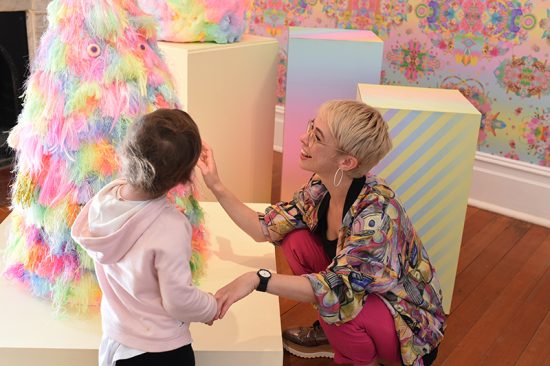
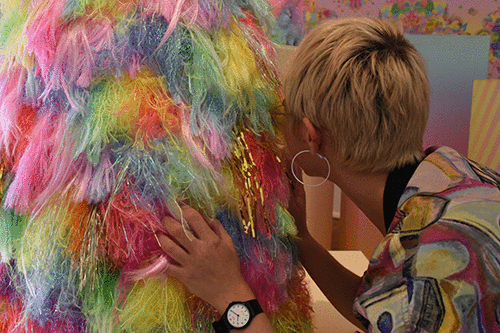
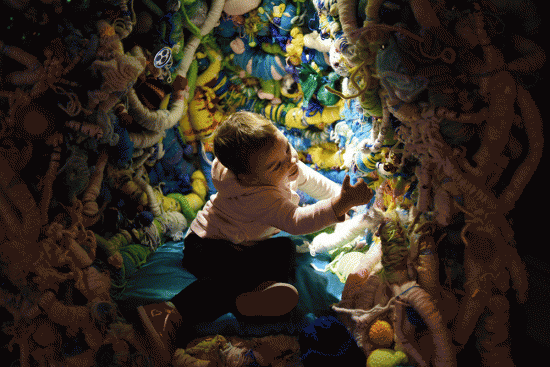
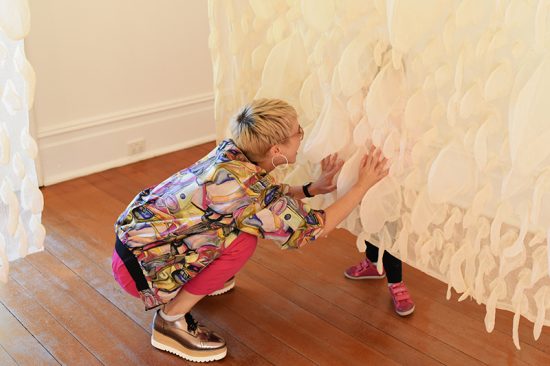
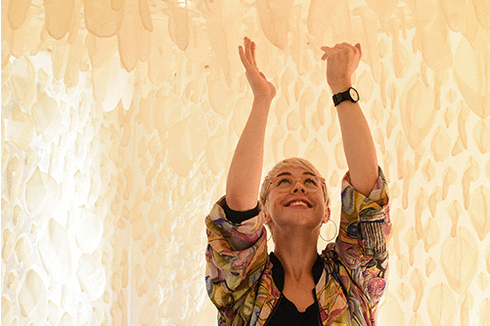
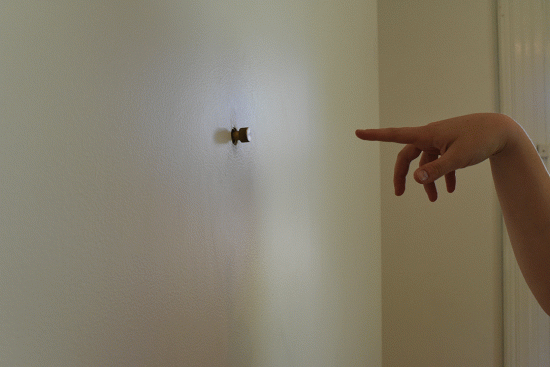

Pingback: Context of ‘softness’ – YUAN